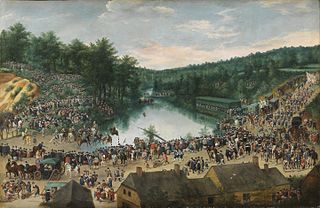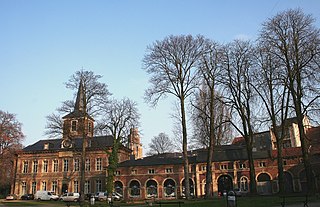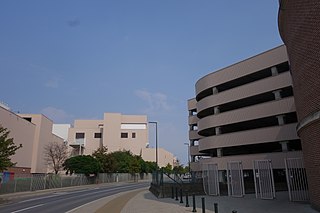Related Research Articles

Dilbeek is a municipality in the province of Flemish Brabant, in the Flemish region of Belgium. The municipality comprises the villages of Dilbeek proper, Groot-Bijgaarden, Itterbeek, Schepdaal, Sint-Martens-Bodegem, and Sint-Ulriks-Kapelle. Dilbeek is located just outside the Brussels-Capital Region, in the Pajottenland, hence the local name Poort van het Pajottenland. Even though Dilbeek is located in the Dutch language area of Belgium, there is a French-speaking minority represented by 3 members on the 35-seat local council. It is a mostly residential community with some preserved rural areas and some industrial zones.

Saint Gudula was born in the pagus of Brabant. According to her 11th-century biography, written by a monk of the abbey of Hautmont between 1048 and 1051, she was the daughter of a duke of Lotharingia called Witger and Amalberga of Maubeuge. She died between 680 and 714.

Forest or Vorst, is one of the 19 municipalities of the Brussels-Capital Region, Belgium. Located in the southern part of the region, it is bordered by Anderlecht, Ixelles, Uccle, and Saint-Gilles, as well as the Flemish municipality of Drogenbos. In common with all of Brussels' municipalities, it is legally bilingual (French–Dutch).

Saint Alena is a Christian saint who, if historical, was martyred around the year 640. She is sometimes referred to as Alena of Forest, or Alena of Brussels, having died in Forest, Belgium which is now one of the nineteen municipalities of Brussels.

Saint Waltrude is the patron saint of Mons, Belgium, where she is known in French as Sainte Waudru, and of Herentals, Belgium, where she is known in Dutch as Sint-Waldetrudis or -Waltrudis. Both cities boast a large medieval church that bears her name.

Denis van Alsloot or Denijs van Alsloot was a Flemish landscape and genre painter, draughtsman, and tapestry designer. He was employed as a court painter and worked for the local elite in Brussels. He is considered to be a member of the Sonian Forest school of landscape painters, which included landscape painters such as Jacques d'Arthois and Cornelis Huysmans. These painters working in Brussels had a preference for depicting scenes from the Sonian Forest near Brussels. Van Alsloot was also a specialist in depicting civil processions, local festivals and ceremonies.

La Cambre Abbey or Ter Kameren Abbey is a former Cistercian abbey in the City of Brussels, Belgium. It is located in the Maelbeek valley between the Bois de la Cambre/Ter Kamerenbos and the Ixelles Ponds. The abbey church is a Catholic parish of the Archdiocese of Mechelen–Brussels and home to a community of Norbertine canons, while other parts of the monastery house the headquarters of the Belgian National Geographic Institute and La Cambre, a prestigious visual arts school.

Rictrude was abbess of Marchiennes Abbey, in Flanders. The main early source for her life is the Vita Rictrudis, commissioned by the abbey, and written in 907 by Hucbald.

Munsterbilzen Abbey was an abbey of Benedictine nuns in Munsterbilzen, Limburg, Belgium, founded in around 670 by Saint Landrada. It was plundered by Vikings in 881 but restored. From the 9th century it was dedicated to Saint Amor.

Anne Charlotte of Lorraine was the Abbess of Remiremont and Mons. She was the thirteenth of fifteen children of Leopold, Duke of Lorraine, and his spouse Élisabeth Charlotte d'Orléans. Her mother was the niece of Louis XIV of France and sister of Philippe II, Duke of Orléans and Regent of France during the minority of Louis XV.

Forest Abbey or Vorst Abbey was a Benedictine abbey located in the Brussels municipality of Forest, Belgium. It was founded in 1105 and existed for nearly 700 years, until its partial destruction by fire in 1764. It was abolished in 1796. Only the abbey's 18th-century outbuildings have been preserved. They are now owned by the municipality and serve as a cultural centre.

Thorn Abbey or the Imperial Abbey of Thorn was an imperial abbey of the Holy Roman Empire in what is now the Netherlands. It was founded in the 10th century and remained independent until 1794, when it was occupied by French troops. The self-ruling abbey enjoyed imperial immediacy and belonged to the Lower Rhenish-Westphalian Circle.

Audi Brussels is an Audi manufacturing plant located in Forest, Belgium, a municipality located in the south-western part of the Brussels-Capital Region.

Mathilde was Abbess of Essen Abbey from 973 to her death. She was one of the most important abbesses in the history of Essen. She was responsible for the abbey, for its buildings, its precious relics, liturgical vessels and manuscripts, its political contacts, and for commissioning translations and overseeing education. In the unreliable list of Essen Abbesses from 1672, she is listed as the second Abbess Mathilde and as a result, she is sometimes called "Mathilde II" to distinguish her from the earlier abbess of the same name, who is meant to have governed Essen Abbey from 907 to 910 but whose existence is disputed.
Adalsinda or Adalsindis of Hamay and Eusebia of Douai, were 7th-century Columban nuns, who were sisters from a prominent Merovingian family; Eusebia became an Abbess. They are venerated as saints in the Catholic and Eastern Orthodox Churches. Their parents were Richtrudis, a Gascoigne-Basque heiress, and Adalbard I of Ostrevent, a Frankish duke of Douai. Both mother and father are also recognised as saints, as are another sister, Clotsinda, and a brother, Maurontius. They are especially venerated in Northern France and Flanders.
Françoise Bette (1593–1666) was, from 1637 to 1666, the 26th abbess of Forest Abbey.

Nivelles Abbey is a former Imperial Abbey of the Holy Roman Empire founded in 640. It is located in Nivelles, Walloon Brabant, Belgium.
Hieronymus van Orley was a Franciscan painter in the Spanish Netherlands.
Adrienne du Petit-Cambrai was the 24th abbess of Forest Abbey.
Joanna de Hertoghe was an abbess of the Cistercian Oosteeklo Abbey in Ghent.
References
- ↑ P. Leroy, "Domein van de abdij van Vorst", in Doorheen de nationale geschiedenis (State Archives in Belgium, Brussels, 1980), p. 207.